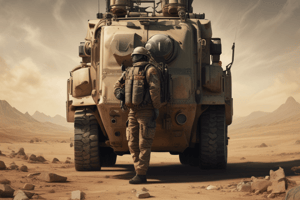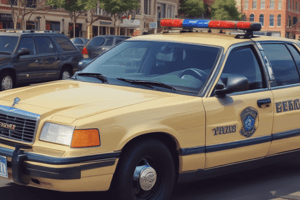Podcast
Questions and Answers
What is the difference between a Code 1 and a Code 3 response?
What is the difference between a Code 1 and a Code 3 response?
- Code 1 is used when there is no need for police presence, while Code 3 is used for rapid response
- Code 1 involves responding to emergency calls, while Code 3 is for non-urgent situations
- Code 1 requires using emergency lights, while Code 3 does not
- Code 1 allows normal driving obeying traffic rules, while Code 3 involves emergency driving with sirens and lights (correct)
Under what circumstances will law enforcement officers respond to calls in a Code 1 response?
Under what circumstances will law enforcement officers respond to calls in a Code 1 response?
- When public safety dispatchers specify an emergency response
- When a police presence and rapid response is not imperative. (correct)
- When a rapid response is imperative
- When a Road Patrol supervisor authorizes a Code 1 response
What determines whether a Code 1 response may be upgraded to a Code 3 response?
What determines whether a Code 1 response may be upgraded to a Code 3 response?
- Presence of an urgent situation at the scene
- Requirement to exceed the speed limits
- Mandate from the public safety dispatchers
- Authorization by an LEO supervisor or a PSD/PSDS (correct)
What is the requirement for LEOs during a Code 1 response?
What is the requirement for LEOs during a Code 1 response?
Which term refers to the vehicle engaged in a Code 3 response?
Which term refers to the vehicle engaged in a Code 3 response?
Under what circumstances can LEO supervisors authorize a Code 3 response to calls not involving a potential threat to citizens?
Under what circumstances can LEO supervisors authorize a Code 3 response to calls not involving a potential threat to citizens?
What is the main responsibility of an LEO when responding to a Code 3 emergency call?
What is the main responsibility of an LEO when responding to a Code 3 emergency call?
What does FSS 316.217 mandate regarding the use of lighted lamps by LEOs?
What does FSS 316.217 mandate regarding the use of lighted lamps by LEOs?
Who has the final authority in authorizing a Code 3 response?
Who has the final authority in authorizing a Code 3 response?
How are incoming calls classified according to priority?
How are incoming calls classified according to priority?
What type of calls require an immediate response by an LEO?
What type of calls require an immediate response by an LEO?
Under what circumstances may Medium or Low Priority calls be delayed?
Under what circumstances may Medium or Low Priority calls be delayed?
What must an LEO do when operating a police vehicle without lighted lamps when required by FSS 316.217?
What must an LEO do when operating a police vehicle without lighted lamps when required by FSS 316.217?
Flashcards are hidden until you start studying





